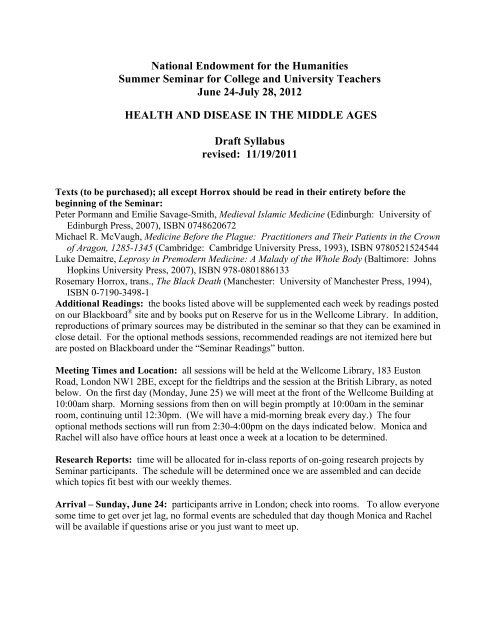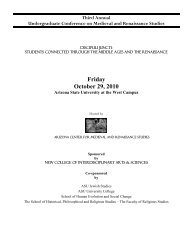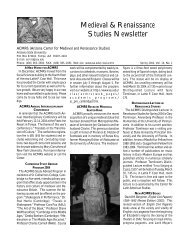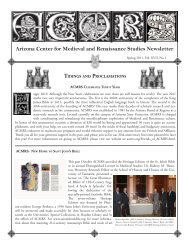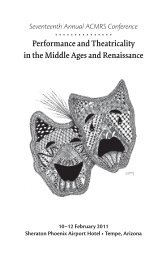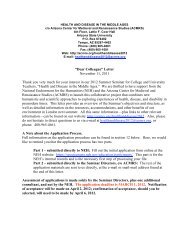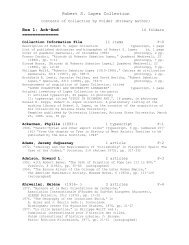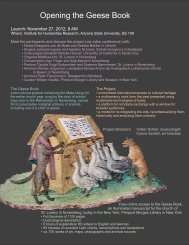NEH syllabus 2012 revised - Health and Disease in the Middle Ages
NEH syllabus 2012 revised - Health and Disease in the Middle Ages
NEH syllabus 2012 revised - Health and Disease in the Middle Ages
You also want an ePaper? Increase the reach of your titles
YUMPU automatically turns print PDFs into web optimized ePapers that Google loves.
National Endowment for <strong>the</strong> HumanitiesSummer Sem<strong>in</strong>ar for College <strong>and</strong> University TeachersJune 24-July 28, <strong>2012</strong>HEALTH AND DISEASE IN THE MIDDLE AGESDraft Syllabus<strong>revised</strong>: 11/19/2011Texts (to be purchased); all except Horrox should be read <strong>in</strong> <strong>the</strong>ir entirety before <strong>the</strong>beg<strong>in</strong>n<strong>in</strong>g of <strong>the</strong> Sem<strong>in</strong>ar:Peter Pormann <strong>and</strong> Emilie Savage-Smith, Medieval Islamic Medic<strong>in</strong>e (Ed<strong>in</strong>burgh: University ofEd<strong>in</strong>burgh Press, 2007), ISBN 0748620672Michael R. McVaugh, Medic<strong>in</strong>e Before <strong>the</strong> Plague: Practitioners <strong>and</strong> Their Patients <strong>in</strong> <strong>the</strong> Crownof Aragon, 1285-1345 (Cambridge: Cambridge University Press, 1993), ISBN 9780521524544Luke Demaitre, Leprosy <strong>in</strong> Premodern Medic<strong>in</strong>e: A Malady of <strong>the</strong> Whole Body (Baltimore: JohnsHopk<strong>in</strong>s University Press, 2007), ISBN 978-0801886133Rosemary Horrox, trans., The Black Death (Manchester: University of Manchester Press, 1994),ISBN 0-7190-3498-1Additional Read<strong>in</strong>gs: <strong>the</strong> books listed above will be supplemented each week by read<strong>in</strong>gs postedon our Blackboard ® site <strong>and</strong> by books put on Reserve for us <strong>in</strong> <strong>the</strong> Wellcome Library. In addition,reproductions of primary sources may be distributed <strong>in</strong> <strong>the</strong> sem<strong>in</strong>ar so that <strong>the</strong>y can be exam<strong>in</strong>ed <strong>in</strong>close detail. For <strong>the</strong> optional methods sessions, recommended read<strong>in</strong>gs are not itemized here butare posted on Blackboard under <strong>the</strong> “Sem<strong>in</strong>ar Read<strong>in</strong>gs” button.Meet<strong>in</strong>g Times <strong>and</strong> Location: all sessions will be held at <strong>the</strong> Wellcome Library, 183 EustonRoad, London NW1 2BE, except for <strong>the</strong> fieldtrips <strong>and</strong> <strong>the</strong> session at <strong>the</strong> British Library, as notedbelow. On <strong>the</strong> first day (Monday, June 25) we will meet at <strong>the</strong> front of <strong>the</strong> Wellcome Build<strong>in</strong>g at10:00am sharp. Morn<strong>in</strong>g sessions from <strong>the</strong>n on will beg<strong>in</strong> promptly at 10:00am <strong>in</strong> <strong>the</strong> sem<strong>in</strong>arroom, cont<strong>in</strong>u<strong>in</strong>g until 12:30pm. (We will have a mid-morn<strong>in</strong>g break every day.) The fouroptional methods sections will run from 2:30-4:00pm on <strong>the</strong> days <strong>in</strong>dicated below. Monica <strong>and</strong>Rachel will also have office hours at least once a week at a location to be determ<strong>in</strong>ed.Research Reports: time will be allocated for <strong>in</strong>-class reports of on-go<strong>in</strong>g research projects bySem<strong>in</strong>ar participants. The schedule will be determ<strong>in</strong>ed once we are assembled <strong>and</strong> can decidewhich topics fit best with our weekly <strong>the</strong>mes.Arrival – Sunday, June 24: participants arrive <strong>in</strong> London; check <strong>in</strong>to rooms. To allow everyonesome time to get over jet lag, no formal events are scheduled that day though Monica <strong>and</strong> Rachelwill be available if questions arise or you just want to meet up.
“<strong>Health</strong> <strong>and</strong> <strong>Disease</strong> <strong>in</strong> <strong>the</strong> <strong>Middle</strong> <strong>Ages</strong>” - Syllabus Page 4Walton O. Schalick, III, “To Market, To Market: The Theory <strong>and</strong> Practice of Opiates <strong>in</strong> <strong>the</strong><strong>Middle</strong> <strong>Ages</strong>,” <strong>in</strong> Opioids <strong>and</strong> Pa<strong>in</strong> Relief: A Historical Perspective, ed. M. Meldrum(Seattle, WA: IASP Press, 2003), pp. 5-20(afternoon) Fieldtrip to <strong>the</strong> Chelsea Physic Garden(http://www.chelseaphysicgarden.co.uk/garden/), meet at 2:00pm at entrance at Swan Walk,London SW3 4HSMat<strong>the</strong>us Platearius (attributed), Circa <strong>in</strong>stans (excerpts)Henry Daniel, Aaron Danielis (excerpts)John H. Harvey, “Henry Daniel: A Scientific Gardener of <strong>the</strong> Fourteenth Century,” GardenHistory 15 (1987), 81-93Alex<strong>and</strong>ra Livarda, “Spic<strong>in</strong>g Up Life <strong>in</strong> Northwestern Europe: Exotic Food Plant Imports <strong>in</strong><strong>the</strong> Roman <strong>and</strong> Medieval World,” Vegetation History <strong>and</strong> Archaeobotany 20, no. 2 (March2011), 143-64Day 3 (Wednesday, July 4): A European Proclivity? The Beg<strong>in</strong>n<strong>in</strong>gs of Anatomical InvestigationEmilie Savage-Smith, “Attitudes toward Dissection <strong>in</strong> Medieval Islam,” Journal of <strong>the</strong> Historyof Medic<strong>in</strong>e <strong>and</strong> Allied Sciences 1995 (50), 67-110Emilie Savage-Smith, “Anatomical Illustration <strong>in</strong> Arabic Manuscripts,” <strong>in</strong> Arab Pa<strong>in</strong>t<strong>in</strong>g: Text<strong>and</strong> Image <strong>in</strong> Illustrated Arabic Manuscripts, ed. Anna Contad<strong>in</strong>i (Leiden: Brill, 2007),pp. 147-59 <strong>and</strong> Figs. 1-6Kathar<strong>in</strong>e Park, Women’s Secrets: Gender, Generation, <strong>and</strong> <strong>the</strong> Orig<strong>in</strong>s of Human Dissection(New York: Zone Books, 2006), chapter 2Day 4 (Thursday, July 5): free day for <strong>in</strong>dividual researchDay 5 (Friday, July 6): free day for <strong>in</strong>dividual researchWeek 3 (July 9-13): History <strong>and</strong> Paleopathology: The Case of LeprosyGuest Lecturer: Luke Demaitre, University of Virg<strong>in</strong>ia, CharlottesvilleTopics for Discussion:• paleopathology: its potential for identify<strong>in</strong>g disease <strong>and</strong> ill health• social conta<strong>in</strong>ment: legal pronouncements <strong>and</strong> <strong>the</strong> role of leprosaria• <strong>the</strong> <strong>in</strong>creased role of <strong>the</strong> medical profession <strong>in</strong> diagnosis <strong>and</strong> management of leprosy• temporal <strong>and</strong> regional variation <strong>in</strong> <strong>the</strong> response to leprosyDay 1 (Monday, July 9): When Did Leprosy Beg<strong>in</strong>? Orig<strong>in</strong>s <strong>and</strong> EvidenceCharlotte Roberts, “The Bioarchaeology of Leprosy <strong>and</strong> Tuberculosis: A Comparative Study ofPerceptions, Stigma, Diagnosis, <strong>and</strong> Treatment,” <strong>in</strong> Social Bioarchaeology, ed. Sabr<strong>in</strong>a C.Agarwal <strong>and</strong> Bonnie A. Glencross (Oxford: Blackwell, 2011), pp. 252-281Jesper L. Boldsen, “Leprosy <strong>in</strong> <strong>the</strong> Early Medieval Lauchheim Community,” American Journalof Physical Anthropology 135 (2008), 301-10Jesper L. Boldsen <strong>and</strong> Lene Mollerup, “Outside St. Jørgen: Leprosy <strong>in</strong> <strong>the</strong> Medieval DanishCity of Odense,” American Journal of Physical Anthropology 130, no. 3 (2006), 344-51references to tsara’ath <strong>in</strong> Leviticus 13-14; references to elephantiasis <strong>in</strong> Aretaeus ofCappadocia, Rufus of Ephesus, <strong>and</strong> early medieval medical texts; references to leprosy(lepra) <strong>in</strong> Luke <strong>and</strong> John <strong>and</strong> <strong>in</strong> early medieval law codesDay 2 (Tuesday, July 10): The “Medieval” <strong>Disease</strong>: Medical <strong>and</strong> Social ResponsesSally L. Burch, “Leprosy <strong>and</strong> Law <strong>in</strong> Béroul’s Roman de Tristan,” Viator 38 (2007), 141-54review Demaitre, Leprosy <strong>in</strong> Premodern Medic<strong>in</strong>e (entire)
“<strong>Health</strong> <strong>and</strong> <strong>Disease</strong> <strong>in</strong> <strong>the</strong> <strong>Middle</strong> <strong>Ages</strong>” - Syllabus Page 5Barbara Sagers, “These are <strong>the</strong> symptoms that we use here for diagnos<strong>in</strong>g leprosy,” <strong>in</strong> Orl<strong>and</strong>aLie, “Record<strong>in</strong>g Practical Experience for Posterity: Barbere Sagers, work<strong>in</strong>g <strong>in</strong> Ghent,1477-1484” (text trans. Myra Heersp<strong>in</strong>k Scholz), <strong>in</strong> Women’s Writ<strong>in</strong>g <strong>in</strong> <strong>the</strong> Low Countries1200-1875. A Bil<strong>in</strong>gual Anthology, ed. L. van Gemert et al. (Amsterdam: AmsterdamUniversity Press, 2010), pp. 130-37Carole Rawcliffe, Leprosy <strong>in</strong> Medieval Engl<strong>and</strong> (Woodbridge: Boydell & Brewer, 2006),chapter 7 “Life <strong>in</strong> <strong>the</strong> Medieval Leper House,” pp. 302-43official records of urban responses; certificates of medical exam<strong>in</strong>ationTuesday, July 10, 2:00pm: Special session on Medical ImagesDay 3 (Wednesday, July 11): Cultural, Chronological, <strong>and</strong> Global ResponsesChrist<strong>in</strong>e M. Boeckl, Images of Leprosy: <strong>Disease</strong>, Religion, <strong>and</strong> Politics <strong>in</strong> European Art(Kirksville, MO: Truman State University Press, 2011), chapter 4 “Development ofLeprosy Iconography,” pp. 67-91Michael W. Dols, “Leprosy <strong>in</strong> Medieval Arabic Medic<strong>in</strong>e,” Journal of <strong>the</strong> History of Medic<strong>in</strong>e<strong>and</strong> Allied Sciences 34, no. 3 (July 1979), 314-33Fred Bergman, “Hop<strong>in</strong>g aga<strong>in</strong>st Hope? A Marital Dispute about <strong>the</strong> Medical Treatment ofLeprosy <strong>in</strong> <strong>the</strong> Fifteenth-Century Hanseatic Town of Kampen,” <strong>in</strong> The Task of Heal<strong>in</strong>g:Medic<strong>in</strong>e, Religion, <strong>and</strong> Gender <strong>in</strong> Engl<strong>and</strong> <strong>and</strong> <strong>the</strong> Ne<strong>the</strong>rl<strong>and</strong>s, 1450-1800, ed. HilaryMarl<strong>and</strong> <strong>and</strong> Margaret Pell<strong>in</strong>g (Rotterdam: Erasmus Publish<strong>in</strong>g, 1996), pp. 23-48François-Olivier Touati, “Contagion <strong>and</strong> Leprosy: Myth, Ideas, <strong>and</strong> Evolution <strong>in</strong> MedievalM<strong>in</strong>ds <strong>and</strong> Societies,” <strong>in</strong> Contagion: Perspectives from Premodern Societies, ed. L. Conrad<strong>and</strong> D. Wujastyk (Aldershot: Ashgate, 1999), 161–83Guglielmo de Saliceto, Leprosy <strong>and</strong> Es<strong>the</strong>tics <strong>in</strong> ItalyTed Gugelyk <strong>and</strong> Milton Bloombaum, The Separat<strong>in</strong>g Sickness, Ma’i Ho’oka’awale:Interviews with Exiled Leprosy Patients at Kalaupapa, Hawaii (Honolulu: The Separat<strong>in</strong>gSickness Foundation, 1996), pp. 29-30, 42-44, 47-48, 51-56Angela Ki Che Leung, Leprosy <strong>in</strong> Ch<strong>in</strong>a: A History (New York: Columbia University Press,2009), chapter 2 “A Cursed but Redeemable Body,” pp. 62-83Susan L. Burns, “From ‘Leper Villages’ to Leprosaria: Public <strong>Health</strong>, Nationalism, <strong>and</strong> <strong>the</strong>Culture of Exclusion <strong>in</strong> Japan,” <strong>in</strong> Isolation: Places <strong>and</strong> Practices of Exclusion, ed. CarolynStrange <strong>and</strong> Alison Bashford (London: Routledge, 2003), pp. 104-18Day 4 (Thursday, July 12): free day for <strong>in</strong>dividual researchDay 5 (Friday, July 13): free day for <strong>in</strong>dividual researchWeek 4 (July 16-20): Can History <strong>and</strong> <strong>the</strong> ‘Historicist Sciences’ WorkToge<strong>the</strong>r? The Case of PlagueGuest Lecturer: Dr. Ann Carmichael, Indiana UniversityTopics for Discussion:• what was <strong>the</strong> disease? The new microbiology of plague• why does it matter how we answer “what was <strong>the</strong> disease”?• who died? documentary sources vs. paleoepidemiology• assess<strong>in</strong>g catastrophe <strong>in</strong> social, economic, <strong>and</strong> political termsDay 1 (Monday, July 16): The Problems with PlaguePeregr<strong>in</strong>e Horden, “Mediterranean Plague <strong>in</strong> <strong>the</strong> Age of Just<strong>in</strong>ian,” <strong>in</strong> The CambridgeCompanion to <strong>the</strong> Age of Just<strong>in</strong>ian, ed. Michael Maas (Cambridge: Cambridge UniversityPress, 2005), pp. 134-160
“<strong>Health</strong> <strong>and</strong> <strong>Disease</strong> <strong>in</strong> <strong>the</strong> <strong>Middle</strong> <strong>Ages</strong>” - Syllabus Page 6Sharon Strocchia, “Review of Samuel Cohn, Jr., The Black Death Transformed: <strong>Disease</strong> <strong>and</strong>Culture <strong>in</strong> Early Renaissance Europe (2002),” Journal of Social History 38, no. 2 (W<strong>in</strong>ter2004), 543-545Michel Drancourt <strong>and</strong> Didier Raoult, “Molecular Insights <strong>in</strong>to <strong>the</strong> History of Plague,”Microbes <strong>and</strong> Infection 4, no. 1 (January 2002), 105-109 [o<strong>the</strong>r articles from <strong>the</strong> “Marseillesschool” can be found on Blackboard]Giovanna Morelli, et al., “Yers<strong>in</strong>ia pestis Genome Sequenc<strong>in</strong>g Identifies Patterns of GlobalPhylogenetic Diversity,” Nature Genetics 42, no. 12 (December 2010), 1140-1145S. Haensch, R. Bianucci, M. Signoli, M. Rajerison, M. Schultz, et al., “Dist<strong>in</strong>ct Clones ofYers<strong>in</strong>ia pestis Caused <strong>the</strong> Black Death,” PLoS Pathog 6, no. 10 (October 2010): e1001134.doi:10.1371/journal.ppat.1001134Day 2 (Tuesday, July 17): Document<strong>in</strong>g CatastropheSharon N. DeWitte <strong>and</strong> James W. Wood, “Selectivity of Black Death Mortality with Respect toPreexist<strong>in</strong>g <strong>Health</strong>,” PNAS 105, no. 5 (February 5, 2008), 1436–1441Michael Dols, “Ibn al-Wardi’s Risalah al-naba’ ‘an al-waba. A Translation of a Major Sourcefor <strong>the</strong> History of <strong>the</strong> Black Death <strong>in</strong> <strong>the</strong> <strong>Middle</strong> East,” <strong>in</strong> Near Eastern Numismatics.Iconography, Epigraphy, <strong>and</strong> History: Studies <strong>in</strong> Honor of George C. Miles, ed. D. K.Kouymijian (Beirut, 1974), pp. 443-55Horrox, Black Death (pages to be assigned)Tuesday, July 17, 2:00pm: Special session on Human Skeletal DataDay 3 (Wednesday, July 18): Plague’s AftermathShona Kelly Wray, “Social Reactions of <strong>the</strong> Populace Dur<strong>in</strong>g <strong>the</strong> Black Death,” chapter 3 ofCommunities <strong>and</strong> Crisis: Bologna dur<strong>in</strong>g <strong>the</strong> Black Death (Leiden: Brill, 2009), pp. 99-146Samuel K. Cohn, Jr, “The Black Death <strong>and</strong> <strong>the</strong> Burn<strong>in</strong>g of Jews,” Past <strong>and</strong> Present 196, no. 1(2007), 3-36, doi:10.1093/pastj/gtm005Michael Dols, “The Comparative Communal Responses to <strong>the</strong> Black Death <strong>in</strong> Muslim <strong>and</strong>Christian Societies,” Viator 5 (1974), 269-287Just<strong>in</strong> K. Stearns, Infectious Ideas: Contagion <strong>in</strong> Premodern Islamic <strong>and</strong> Christian Thought <strong>in</strong><strong>the</strong> Western Mediterranean (Baltimore: Johns Hopk<strong>in</strong>s University Press, 2011), chaps. 3-4Nicole Archambeau, “Heal<strong>in</strong>g Options dur<strong>in</strong>g <strong>the</strong> Plague: Survivor Stories from a Fourteenth-Century Canonization Inquest,” Bullet<strong>in</strong> of <strong>the</strong> History of Medic<strong>in</strong>e 85 (forthcom<strong>in</strong>g)Day 4 (Thursday, July 19): Fieldtrip to Human Bioarchaeology Centre, Museum of London(http://www.museumoflondon.org.uk/English/Collections/Onl<strong>in</strong>eResources/CHB/), meet at10:00am at 150 London Wall, London EC2Y 5HNDuncan Hawk<strong>in</strong>s, “The Black Death <strong>and</strong> <strong>the</strong> New London Cemeteries of 1348,” Antiquity 64(1990), 637-642“East Smithfield Black Death Cemetery” (available athttp://www.museumoflondon.org.uk/Collections-Research/LAARC/Centre-for-Human-Bioarchaeology/Database/Medieval+cemeteries/ESmithfieldBlackDeath.htm)Day 5 (Friday, July 20): free day for <strong>in</strong>dividual researchWeek 5 (July 23-27): The Limits of Physical Cure: Hierarchies of ResortTopics for Discussion:• what could learned medic<strong>in</strong>e actually provide? <strong>and</strong> what could empirical medic<strong>in</strong>e provide?• regimens, “self-help”, <strong>and</strong> <strong>the</strong> lay medical reader• social safety nets: <strong>the</strong> <strong>in</strong>stitutions of charity <strong>and</strong> <strong>the</strong> role of hospitals
“<strong>Health</strong> <strong>and</strong> <strong>Disease</strong> <strong>in</strong> <strong>the</strong> <strong>Middle</strong> <strong>Ages</strong>” - Syllabus Page 8skeletal data <strong>and</strong> analyses <strong>in</strong>to <strong>the</strong>ir work. Recommended background read<strong>in</strong>gs can be found under<strong>the</strong> “Sem<strong>in</strong>ar Read<strong>in</strong>gs” button on Blackboard.Week 1 (Wednesday, June 27): Onl<strong>in</strong>e Resources for <strong>the</strong> History of Medic<strong>in</strong>eWeek 2 (Monday, July 2): Medical Paleography (for participants already tra<strong>in</strong>ed <strong>in</strong> basicpaleography) – a special presentation at <strong>the</strong> British Library Manuscripts RoomWeek 3 (Tuesday, July 10): Medical ImagesWeek 4 (Tuesday, July 17): Human Skeletal DataGeneral Bibliography on Medieval Medic<strong>in</strong>e:Allen, David E., <strong>and</strong> Gabriele Hatfield. Medic<strong>in</strong>al Plants <strong>in</strong> Folk Tradition: An Ethnobotany ofBrita<strong>in</strong> <strong>and</strong> Irel<strong>and</strong> (Cambridge: Timber Press, 2004), ISBN 0 8819 2638Amasuno Sárraga, Marcel<strong>in</strong>o V. Medic<strong>in</strong>a ante la ley: La “licencia practic<strong>and</strong>i” y el ejercicio dela medic<strong>in</strong>a en la Castilla bajomedieval (Valladolid: Junta de Castilla y León, 2002), ISBN8497180712Baker, Patricia A., Kar<strong>in</strong>e van t’L<strong>and</strong>, <strong>and</strong> Han Nijdam, eds. Medic<strong>in</strong>e <strong>and</strong> Space: Body,Surround<strong>in</strong>gs <strong>and</strong> Borders <strong>in</strong> Antiquity <strong>and</strong> <strong>the</strong> <strong>Middle</strong> <strong>Ages</strong>, Visualiz<strong>in</strong>g <strong>the</strong> <strong>Middle</strong> <strong>Ages</strong>(Leiden: Brill, 2011), ISBN 9789004216099Benedictow, Ole J. The Black Death, 1346–1353: The Complete History (Woodbridge, Suffolk:Boydell Press, 2004), ISBN-13: 978-1843832140Benedictow, Ole J. What <strong>Disease</strong> was Plague? On <strong>the</strong> Controversy over <strong>the</strong> MicrobiologicalIdentity of Plague Epidemics of <strong>the</strong> Past (Leiden: Brill, 2011), ISBN 9789004180024Bénézet, Jean-Pierre. Pharmacie et médicament en Méditerranée occidentale (XIIIe-XVIe siècles),Sciences, Techniques et Civilisations du Moyen Âge à l’Aube des Lumières (Paris: HonoréChampion, 1999), ISBN 2-7453-0001-6Biller, Peter, <strong>and</strong> Joseph Ziegler, eds. Religion <strong>and</strong> Medic<strong>in</strong>e <strong>in</strong> <strong>the</strong> <strong>Middle</strong> <strong>Ages</strong>, York Studies <strong>in</strong>Medieval Theology, 3 (York: York Medieval Press, 2001), ISBN 1903153077Bisgaard, Lars, <strong>and</strong> Leif Søndergaard, eds., Liv<strong>in</strong>g with <strong>the</strong> Black Death d. (Odense: UniversityPress of Sou<strong>the</strong>rn Denmark, 2009), ISBN 978-87-7674-389-5Borsch, Stuart. The Black Death <strong>in</strong> Egypt <strong>and</strong> Engl<strong>and</strong>: A Comparative Study (Aust<strong>in</strong>, TX:University of Texas Press, 2005), 978-0-292-72213-2Bowers, Barbara S., ed. The Medieval Hospital <strong>and</strong> Medical Practice (Aldershot: Ashgate, 2007),ISBN 0 7546 5110 XCamille, Michael. Master of Death: The Lifeless Art of Pierre Remiet, Illum<strong>in</strong>ator (New Haven:Yale University Press, 1996), ISBN 9780300064575Carmichael, Ann. Plague <strong>and</strong> <strong>the</strong> Poor <strong>in</strong> Renaissance Florence (Cambridge: CambridgeUniversity Press, 1986), ISBN 0-521-26833-8Collard, Franck, <strong>and</strong> Evelynne Samame, eds. Le corps à l’épreuve: Poisons, remédes et chirurgie:aspects des pratiques médicales dans l’Antiquité et au Moyen Âge, Hommes et textes enChampagne (Prez-sur-Marne: D. Guéniot, 2002), ISBN 2-87825-233-0Collard, Franck. The Crime of Poison <strong>in</strong> <strong>the</strong> <strong>Middle</strong> <strong>Ages</strong>, trans. Deborah Nelson-Campbell (NewYork: ABC-Clio, 2008), ISBN 978-0-31334-699-6Cowal, Lynne, Ian Gra<strong>in</strong>ger, Duncan Hawk<strong>in</strong>s, <strong>and</strong> Richard Mikulski, eds. The Black DeathCemetery, East Smithfield, London, Museum of London Archaeology Service, Monograph 43(London: Museum of London, 2008), ISBN 978-1-901992-82-3Crislip, Andrew T. From Monastery to Hospital: Christian Monasticism <strong>and</strong> <strong>the</strong> Transformation of<strong>Health</strong> Care <strong>in</strong> Late Antiquity (Ann Arbor: University of Michigan Press, 2005), ISBN 0–472–11474–3
“<strong>Health</strong> <strong>and</strong> <strong>Disease</strong> <strong>in</strong> <strong>the</strong> <strong>Middle</strong> <strong>Ages</strong>” - Syllabus Page 10Horden, Peregr<strong>in</strong>e. Hospitals <strong>and</strong> Heal<strong>in</strong>g from Antiquity to <strong>the</strong> Later <strong>Middle</strong> <strong>Ages</strong> (Aldershot:Ashgate, 2008), ISBN 978-0-7546-6181-8——, <strong>and</strong> Emilie Savage-Smith, eds. The Year 1000: Medical Practice at <strong>the</strong> End of <strong>the</strong> FirstMillennium, special issue of Social History of Medic<strong>in</strong>e, 13.2 (August 2000), ISSN 1477-4666Hunt, Tony. Anglo-Norman Medic<strong>in</strong>e, 2 vols. (Cambridge: D. S. Brewer, 1994-1997), ISBN0859914011 <strong>and</strong> 0859915239Jacquart, Danielle, <strong>and</strong> Françoise Micheau. La médec<strong>in</strong>e arabe et l’Occident médiéval (Paris :Maisonneuve et Larose, 1990), ISBN 2-7068-1004-1Jones, Peter Murray. Medieval Medic<strong>in</strong>e <strong>in</strong> Illum<strong>in</strong>ated Manuscripts, rev. ed. (London: BritishLibrary [by] arrangement with Centro Tibaldi, 1998), ISBN 0712306579Little, Lester K., ed. Plague <strong>and</strong> <strong>the</strong> End of Antiquity: The P<strong>and</strong>emic of 541-750 (Cambridge:Cambridge University Press, 2006), ISBN 0-521-84639-0Luttrell, Anthony, <strong>and</strong> Helen J. Nicholson, eds. Hospitaller Women <strong>in</strong> <strong>the</strong> <strong>Middle</strong> <strong>Ages</strong> (Aldershot:Ashgate, 2006), ISBN 0-7546-0646-5McVaugh, Michael R. The Rational Surgery of <strong>the</strong> <strong>Middle</strong> <strong>Ages</strong>, Micrologus’ Library, 15 (Firenze:SISMEL, 2006), ISBN 88-8450-199-7Metzler, Ir<strong>in</strong>a. Disability <strong>in</strong> Medieval Europe: Physical Impairment <strong>in</strong> <strong>the</strong> High <strong>Middle</strong> <strong>Ages</strong>,c.1100 - c.1400 (London: Routledge, 2006), ISBN 9780415365031Mitchell, Piers D. Medic<strong>in</strong>e <strong>in</strong> <strong>the</strong> Crusades: Warfare, Wounds <strong>and</strong> <strong>the</strong> Medieval Surgeon(Cambridge: Cambridge University Press, 2004), ISBN 0-521-84455-XMontford, Angela. <strong>Health</strong>, Sickness, Medic<strong>in</strong>e <strong>and</strong> <strong>the</strong> Friars <strong>in</strong> <strong>the</strong> Thirteenth <strong>and</strong> FourteenthCenturies (Ashgate, 2004), ISBN 0-7546-3697-6Moore, R. I. The Formation of a Persecut<strong>in</strong>g Society: Power <strong>and</strong> Deviance <strong>in</strong> Western Europe,950-1250, 2nd ed. <strong>revised</strong> (Oxford: Basil Blackwell, 2007), ISBN 1405129646Nicoud, Marilyn. Les régimes de santé au Moyen Âge: naissance et diffusion d’une écrituremédicale, XIIIe–XVe siècle. Bibliothèque des Écoles françaises d’Athènes et de Rome, 333([Rome]: École française de Rome, 2007), ISBN 9782728308019Nutton, Vivian. Ancient Medic<strong>in</strong>e (NY: Routledge, 2004), ISBN 0415086116Park, Kathar<strong>in</strong>e. Women’s Secrets: Gender, Generation, <strong>and</strong> <strong>the</strong> Orig<strong>in</strong>s of Human Dissection(New York: Zone Books, 2006), ISBN 1890951676La peste nera: dati di una realtà ed elementi di una <strong>in</strong>terpretazione. Atti del XXX Convegno storico<strong>in</strong>ternazionale, Todi, 10-13 ottobre 1993 (Spoleto: Centro Italiano di Studi Sull’Alto Medioevo1994), ISBN 978-8879883962Pormann, Peter, ed. Islamic Medical <strong>and</strong> Scientific Tradition, 4 vols. (New York: Routledge,2010), ISBN: 978-0-415-47953-0. A collection of repr<strong>in</strong>ted essays; vols. 1-2 conta<strong>in</strong> essays onmedic<strong>in</strong>e.Rawcliffe, Carole. Medic<strong>in</strong>e <strong>and</strong> Society <strong>in</strong> Later Medieval Engl<strong>and</strong> (Stroud, Gloucestershire: A.Sutton, 1995), ISBN 0-7509-1497-1 (out of pr<strong>in</strong>t; copies may be available on <strong>the</strong> Internet)Rawcliffe, Carole. Medic<strong>in</strong>e for <strong>the</strong> Soul: The Life, Death <strong>and</strong> Resurrection of an English MedievalHospital (Thrupp, Stroud, Gloucestershire: Sutton Publish<strong>in</strong>g, 1999), ISBN 9780750920094Rawcliffe, Carole. Leprosy <strong>in</strong> Medieval Engl<strong>and</strong> (Woodbridge: Boydell & Brewer, 2006), ISBN1843832739Roberts, Charlotte A., <strong>and</strong> Jane E. Buikstra. The Bioarchaeology of Tuberculosis. A Global View ona Reemerg<strong>in</strong>g <strong>Disease</strong> (Ga<strong>in</strong>esville, Florida: University Press of Florida, 2008), ISBN 978-0-8130-3269-6
“<strong>Health</strong> <strong>and</strong> <strong>Disease</strong> <strong>in</strong> <strong>the</strong> <strong>Middle</strong> <strong>Ages</strong>” - Syllabus Page 11Roberts, Charlotte A., Mary E. Lewis, <strong>and</strong> Keith Manchester. The Past <strong>and</strong> Present of Leprosy.Archaeological, Historical, Palaeopathological <strong>and</strong> Cl<strong>in</strong>ical Approaches (Oxford:Archaeopress, 2002), ISBN 1841714348Savage-Smith, Emilie. A New Catalogue of Arabic Manuscripts <strong>in</strong> <strong>the</strong> Bodleian Library,University of Oxford. Volume I: Medic<strong>in</strong>e (Oxford: Oxford University Press, 2011), ISBN9780199513581Schmitz, Rudolf, with <strong>the</strong> assistance of Franz-Josef Kuhlen. Geschichte der Pharmazie. Vol. 1, Vonden Anfängen bis zum Ausgang des Mittelalters Eschborn, Germany: Govi Press, 1998), ISBN978-3774107069Shatzmiller, Joseph. Jews, Medic<strong>in</strong>e <strong>and</strong> Medieval Society (Berkeley: University of CaliforniaPress, 1995), ISBN 0520080599Sloane, Barney. The Black Death <strong>in</strong> London (London: The History Press, 2011), ISBN9780752428291Taavitsa<strong>in</strong>en, Irma, Päivi Pahta, <strong>and</strong> Martti Mäk<strong>in</strong>en, eds. <strong>Middle</strong> English Medical Texts (Hels<strong>in</strong>ki:University of Hels<strong>in</strong>ki, 2005), CD-ROM, ISBN 90 272 3230 XTavorm<strong>in</strong>a, M. Teresa, ed. Sex, Ag<strong>in</strong>g, <strong>and</strong> Death <strong>in</strong> a Medieval Medical Compendium: Tr<strong>in</strong>ityCollege Cambridge MS R.14.52, Its Texts, Language, <strong>and</strong> Scribe (Tempe, AZ: Arizona Centerfor Medieval <strong>and</strong> Renaissance Studies, 2006), ISBN 0-86698-335-XTabuteau, Bruno, ed. Lépreux et sociabilité du Moyen Âge aux temps modernes, Cahiers duGRHIS, 11 (Rouen: Publications de l’Université de Rouen, 2000), ISBN 9782877752879Touati, François-Olivier. Archives de la lèpre: Atlas des léproseries entre Loire et Marne auMoyen Age (Paris : Editions du C.T.H.S., 1996), ISBN 2735503445Vela i Aulesa, Carles. L’obrador d’un apotecari medieval segons el llibre de comptes de Francescses Canes (Barcelona, 1378–1381) (Barcelona: CSIC, 2003), ISBN 9788400081829Voigts, L<strong>in</strong>da Ehrsam, <strong>and</strong> Patricia Deery Kurtz, eds. Scientific <strong>and</strong> Medical Writ<strong>in</strong>gs <strong>in</strong> Old <strong>and</strong><strong>Middle</strong> English: An Electronic Reference, The Society for Early English & Norse ElectronicTexts (Ann Arbor: University of Michigan Press, 2000), CD-ROM, ISBN 0-472-00279-1Wack, Mary F. Lovesickness <strong>in</strong> <strong>the</strong> <strong>Middle</strong> <strong>Ages</strong>: The ‘Viaticum’ <strong>and</strong> its Commentaries(Philadelphia: University of Pennsylvania Press, 1990), ISBN 081228142XWallis, Faith, ed. Medieval Medic<strong>in</strong>e: A Reader (Toronto: University of Toronto Press, 2010),ISBN 9781442601031Wray, Shona Kelly. Communities <strong>and</strong> Crisis: Bologna dur<strong>in</strong>g <strong>the</strong> Black Death, The MedievalMediterranean: Peoples, Economies <strong>and</strong> Cultures, 400-1500, 83 (Leiden: Brill, 2009), ISBN9789004176348Disclaimer: Any views, f<strong>in</strong>d<strong>in</strong>gs, conclusions or recommendations expressed <strong>in</strong> this program do notnecessarily represent those of <strong>the</strong> National Endowment for <strong>the</strong> Humanities.


